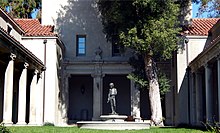
Claremont is a suburban city on the eastern edge of Los Angeles County, California, United States, 30 miles (48 km) east of downtown Los Angeles. It is in the Pomona Valley, at the foothills of the San Gabriel Mountains. As of the 2010 census it had a population of 34,926, and in 2019 the estimated population was 36,266.

The Claremont Colleges are a consortium of seven private institutions of higher education located in Claremont, California, United States. They comprise five undergraduate colleges —Pomona College, Scripps College, Claremont McKenna College (CMC), Harvey Mudd College, and Pitzer College—and two graduate schools—Claremont Graduate University (CGU) and Keck Graduate Institute (KGI). All the members except KGI have adjoining campuses, together covering roughly 1 sq mi (2.6 km2).

Pomona College is a private liberal arts college in Claremont, California. It was established in 1887 by a group of Congregationalists who wanted to recreate a "college of the New England type" in Southern California. In 1925, it became the founding member of the Claremont Colleges consortium of adjacent, affiliated institutions.

In classical architecture, a colonnade is a long sequence of columns joined by their entablature, often free-standing, or part of a building. Paired or multiple pairs of columns are normally employed in a colonnade which can be straight or curved. The space enclosed may be covered or open. In St. Peter's Square in Rome, Bernini's great colonnade encloses a vast open elliptical space.

Scripps College is a private liberal arts women's college in Claremont, California. It was founded as a member of the Claremont Colleges in 1926, a year after the consortium's formation. Journalist and philanthropist Ellen Browning Scripps provided its initial endowment.

Pitzer College is a private liberal arts college in Claremont, California. One of the Claremont Colleges, the college has a curricular emphasis on the social sciences, behavioral sciences, international programs, and media studies. Pitzer is known for its social justice culture and experimental pedagogical approach.

The Student Life is a student newspaper covering the Claremont Colleges, a consortium of liberal arts colleges in Claremont, California. It is published weekly each Friday during the academic year, typically spans roughly ten pages per issue, and is primarily funded by the student governments of the colleges.

The Pomona College Organic Farm is an organic campus farm on 1.2 acres (0.49 ha) of the southeast corner of Pomona College's campus in Claremont, California. It is within Blanchard Park. It was begun as an experimental permaculture project by a group of three friends in 1998, and was institutionalized in 2006.

Myron Hubbard Hunt was an American architect whose numerous projects include many noted landmarks in Southern California and Evanston, Illinois. Hunt was elected a Fellow in the American Institute of Architects in 1908.

Burt William Johnson was an American sculptor.

Charles Keyser Edmunds was an American engineer and physicist who served as president of Lingnan University in Canton, China, and Pomona College in Claremont, California.

The Spirit of Spanish Music is a sculpture by Burt William Johnson . It was commissioned by the Pomona College class of 1915 and placed in the Lebus Court of the Mabel Shaw Bridges Hall of Music at Pomona College, one of a group of buildings conceived for the expansion of Pomona College and built in the mid-1910s by architect Myron Hunt using details of the "ornamental Spanish style".

The Mabel Shaw Bridges Music Auditorium, more commonly known as Bridges Auditorium or Big Bridges, is a 2500-seat auditorium at Pomona College in Claremont, California, United States. It was designed by William Templeton Johnson and opened in 1932. It hosts a variety of performances for the college and outside groups.

The Pomona–Pitzer Sagehens are the joint varsity intercollegiate athletic programs for Pomona College and Pitzer College, two of the Claremont Colleges. It competes with 11 women's and 10 men's teams in the Southern California Intercollegiate Athletic Conference (SCIAC) of the NCAA Division III.

Numerous traditions have been established at Pomona College, a highly selective liberal arts college in Claremont, California, since its founding in 1887. They have varying levels of popularity, longevity, and institutional recognition. Taken together, they are a significant component of the school's culture and identity, promoting social cohesion among students and other community members.

On the Loose is an outing club for the undergraduate Claremont Colleges (5Cs), a consortium of five highly selective liberal arts colleges based in Claremont, California. It organizes trips to outdoor destinations around Southern California and the Western United States.

The Associated Students of Pomona College, commonly abbreviated as ASPC, is the student government of Pomona College, an elite liberal arts college in Claremont, California, United States. It was founded in 1904, and is composed of elected representatives. Its primary functions are distributing extracurricular funds, conducting advocacy, running student programming, and providing various student services.

The Benton Museum of Art at Pomona College, known colloquially as the Benton, is an art museum at Pomona College in Claremont, California. It was completed in 2020, replacing the Montgomery Art Gallery, which had been home to the Pomona College Museum of Art (PCMA) since 1958. It houses a collection of approximately 19,000 items, including Italian Renaissance panel paintings, indigenous American art and artifacts, and American and European prints, drawings, and photographs. The museum is free to the public.

Charles Burt Sumner was a minister in the Congregational church and a founding trustee of Pomona College who served as its de facto first president.























